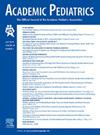Health Care Use by Immigrant Generation in Low-Income Children With Special Health Care Needs
IF 2.8
3区 医学
Q1 PEDIATRICS
引用次数: 0
Abstract
Objective
We aimed to describe social stressors and health care access in children with special health care needs (CSHCN) from low-income households by immigrant generation and determine the association between immigrant generation and health care utilization.
Methods
This was a retrospective cross-sectional study of CSHCN living at or below 200% of the federal poverty level using the National Survey of Children’s Health from 2018 to 2022. Exposures were demographics, immigrant generation (first-generation, second-generation, or nonimmigrant), social stressors, and health care factors. Outcomes were 1) one or more emergency room (ER) visits and 2) one or more hospitalizations in the past year. We compared variables across generations using chi-square testing and assessed factors associated with our outcomes using logistic regression.
Results
We included 16,679 CSHCN (293 first-generation, 2203 second-generation, 14,183 nonimmigrants). Compared to second-generation and nonimmigrants, more parents of first-generation CSHCN identified as Hispanic, lived in non-English speaking households, reduced work hours due to their child’s health, reported poor child health, lacked insurance for their child, and lacked a medical home for their child. ER visits and hospitalization rates were similar across all 3 generation groups. When controlling for covariates, immigrant generation was not associated with ER visits or hospitalizations.
Conclusions
Despite having poorer health status and less access to medical homes compared to nonimmigrants, CSHCN from immigrant families do not utilize the ER more often, which is potentially concerning for underutilization. Addressing social drivers of health in immigrant families and expanding public health insurance eligibility to all low-income CSHCN, regardless of immigration status, may ensure appropriate ER use.
有特殊医疗需求的低收入儿童移民一代的医疗保健使用情况。
目的:本研究旨在描述移民世代低收入家庭特殊医疗需求儿童(CSHCN)的社会压力源与医疗保健可及性,并确定移民世代与医疗保健利用之间的关系。方法:采用2018-2022年全国儿童健康调查,对生活在联邦贫困水平200%或以下的CSHCN进行回顾性横断面研究。暴露因素包括人口统计学因素、移民一代(第一代、第二代或非移民)、社会压力因素和医疗保健因素。结果是1)一次或多次急诊室(ER)访问和2)过去一年一次或多次住院。我们使用卡方检验比较各代变量,并使用逻辑回归评估与结果相关的因素。结果:我们纳入了16679名CSHCN(第一代293人,第二代2203人,非移民14183人)。与第二代和非移民相比,更多的第一代CSHCN父母被认定为西班牙裔,生活在非英语家庭,由于孩子的健康而减少工作时间,报告孩子健康状况不佳,他们的孩子没有保险,他们的孩子没有医疗之家。在所有三代人中,急诊室就诊和住院率相似。当控制协变量时,移民世代与急诊室就诊或住院无关。结论:尽管与非移民家庭相比,移民家庭的CSHCN健康状况较差,去医院的机会较少,但他们并不经常利用急诊室,这可能与利用不足有关。解决移民家庭健康的社会驱动因素,并将公共医疗保险资格扩大到所有低收入的CSHCN,无论移民身份如何,都可以确保急诊室的适当使用。
本文章由计算机程序翻译,如有差异,请以英文原文为准。
求助全文
约1分钟内获得全文
求助全文
来源期刊

Academic Pediatrics
PEDIATRICS-
CiteScore
4.60
自引率
12.90%
发文量
300
审稿时长
60 days
期刊介绍:
Academic Pediatrics, the official journal of the Academic Pediatric Association, is a peer-reviewed publication whose purpose is to strengthen the research and educational base of academic general pediatrics. The journal provides leadership in pediatric education, research, patient care and advocacy. Content areas include pediatric education, emergency medicine, injury, abuse, behavioral pediatrics, holistic medicine, child health services and health policy,and the environment. The journal provides an active forum for the presentation of pediatric educational research in diverse settings, involving medical students, residents, fellows, and practicing professionals. The journal also emphasizes important research relating to the quality of child health care, health care policy, and the organization of child health services. It also includes systematic reviews of primary care interventions and important methodologic papers to aid research in child health and education.
 求助内容:
求助内容: 应助结果提醒方式:
应助结果提醒方式:


